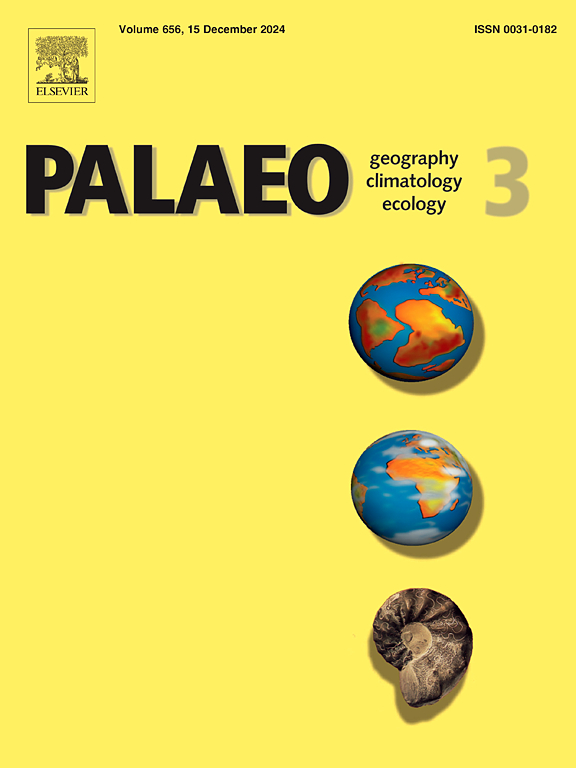Earliest trace fossil evidence of wood-eating termites (Isoptera) and mites (Oribatida) in circumpolar environments of Australia
IF 2.7
2区 地球科学
Q2 GEOGRAPHY, PHYSICAL
Palaeogeography, Palaeoclimatology, Palaeoecology
Pub Date : 2025-06-03
DOI:10.1016/j.palaeo.2025.113059
引用次数: 0
Abstract
Termites (Suborder Isoptera) first appear in the fossil record in the Upper Jurassic and quickly gained global distribution afterwards. Here we describe and diagnose a coalified conifer log filled with a complex suite of xylophagy-related trace fossils. Sourced from the upper Strzelecki Group (Hauterivian-Albian) of southeastern Australia, the log comes from a unit that records the sedimentary history of a massive braided river system, featuring volcaniclastic sandstones interbedded with conglomerates, mudstones, and prolific thin coal sheets. We employed multiple imaging methods to analyse the specimen, such as thin sectioning, CT scanning, X-ray fluorescence microscopy, and Raman spectroscopy. Trace fossils consist of two distinct sizes of tunnel filled with abundant coprolites and post-burial clastic sediment, with one type an order of magnitude smaller than the other. The larger coprolites within tunnels are carbonaceous with hexagonal cross-sections, and are identifiable as Microcarpolithes hexagonalis, an ichnotaxon commonly related to modern drywood termites (Family Kalotermitidae). Oribatid mites (Acari) are identified as the trace makers of the smaller coprolites and tunnels. The log itself served as a vessel for transporting these trace fossils, having likely originated from an upland forest before its deposition on a rift-valley fluvial floodplain. The paleobiogeographic and behavioural implications of these trace fossils are significant, as this specimen constitutes the earliest record of Isoptera in Australia, the southernmost record of Isoptera in the fossil record and the only record of Isoptera within a circumpolar environment. The presence of termites in the upper Strzelecki Group (within the Antarctic Circle) suggests they had a global distribution by the Early Cretaceous. These termite trace fossils also support times when permafrost was likely absent in the Early Cretaceous if modern termites' vulnerability to prolonged freezing conditions is ancestral.
澳大利亚极地周围环境中发现的最早的食木白蚁(等翅目)和蚁类的化石证据
白蚁(等翅亚目)最早出现于上侏罗统化石记录中,此后迅速在全球分布。在这里,我们描述和诊断一个联合针叶树原木充满了一个复杂的套件木食相关的痕迹化石。该测井资料来自澳大利亚东南部的上部Strzelecki组(Hauterivian-Albian),记录了一个大型辫状河系统的沉积历史,该系统以火山碎屑砂岩与砾岩、泥岩和丰富的薄煤层互层为特征。我们采用多种成像方法对标本进行分析,如薄切片、CT扫描、x射线荧光显微镜、拉曼光谱等。痕迹化石由两种不同大小的隧道组成,隧道中充满了丰富的粪化石和埋后碎屑沉积物,其中一种比另一种小一个数量级。隧道内较大的粪化石为碳质六角形截面,可识别为Microcarpolithes hexonalis,与现代干木白蚁(Kalotermitidae)有密切关系。甲螨(Acari)被认为是小粪化石和隧道的痕迹制造者。原木本身就充当了运输这些化石痕迹的容器,很可能在沉积在裂谷河流泛滥平原之前起源于高地森林。这些化石的古生物地理学和行为学意义重大,因为该标本构成了澳大利亚最早的等翅目记录,是化石记录中最南端的等翅目记录,也是环极地环境中唯一的等翅目记录。白蚁在Strzelecki群上(南极圈内)的存在表明,白蚁在早白垩纪就已经在全球分布了。如果现代白蚁对长时间冰冻环境的脆弱性是祖传的,那么这些白蚁痕迹化石也支持了白垩纪早期可能没有永久冻土的时代。
本文章由计算机程序翻译,如有差异,请以英文原文为准。
求助全文
约1分钟内获得全文
求助全文
来源期刊
CiteScore
5.90
自引率
10.00%
发文量
398
审稿时长
3.8 months
期刊介绍:
Palaeogeography, Palaeoclimatology, Palaeoecology is an international medium for the publication of high quality and multidisciplinary, original studies and comprehensive reviews in the field of palaeo-environmental geology. The journal aims at bringing together data with global implications from research in the many different disciplines involved in palaeo-environmental investigations.
By cutting across the boundaries of established sciences, it provides an interdisciplinary forum where issues of general interest can be discussed.

 求助内容:
求助内容: 应助结果提醒方式:
应助结果提醒方式:


